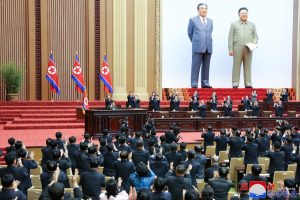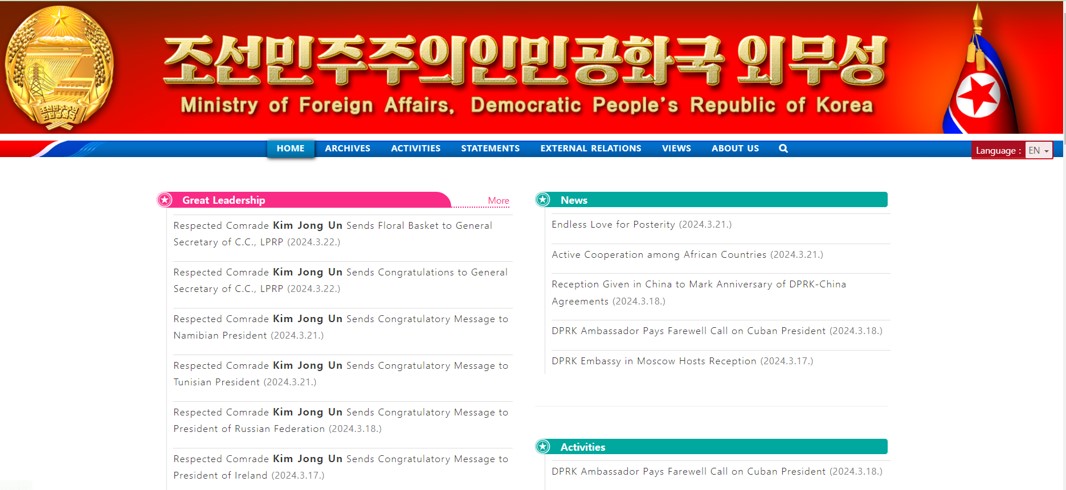North Korean Foreign Ministry Website: Overview

In June 2017, the Democratic People’s Republic of Korea (DPRK or North Korea) announced that it had opened its own Foreign Ministry website. Although the website’s launch was announced in June, website content goes back as far as April that year. Similar to websites of other countries’ foreign ministries, it contains information on the structure of the ministry itself as well as documents, statements, and reports relevant to Pyongyang’s foreign policy.
Unsurprisingly, some of the website’s content is aimed at putting the North in a favorable light. Apart from that, it contains information that, if followed closely, helps fill in the picture of the North’s plans and perceptions about what the country considers to be key foreign policy issues.
A review of the website’s mechanics and the apparent rise and fall of its importance for analysts since 2017 shows that the website was particularly useful for tracking major changes in North Korea’s foreign policy in the summer of 2021. Although the website’s role as a key foreign policy platform has declined in recent months, it is premature to write off its importance altogether.
Overview
The website—available in Korean, English, Chinese, Russian and Spanish—is divided into eight sections:
- Archives: Works and speeches by the Kim leaders
- Activities: The North Korean Foreign Ministry’s activities at home and abroad
- Statements: Statements and articles from the Foreign Ministry, Foreign Ministry institutes and “civil organizations” backed by the Foreign Ministry
- External Relations: Diplomatic activities at home and abroad not included in the “Activities” section, including foreign leaders’ telegrams to Kim Jong Un
- Views (“International Trends” on the Korean page): Reports on international issues and foreign entities praising North Korea
- Great Leadership: Reports on Kim Jong Un’s activities, including his letters to foreign leaders
- News: A listing of highlights or key items from other sections of the website, excluding Kim’s activities, usually going back by a few days
- Our Reality: Articles praising the Kim leaders or the North Korean system
In addition, there is an “About Us” page on the website that gives an overview of the Foreign Ministry’s composition, its institutes and “civil organizations” sponsored by the ministry.

Generally speaking, websites can be notoriously difficult to design, navigate, and search. This one is no different. Not every part of the website is equally valuable—of course, that depends on what you are looking for—and there is not always an obvious explanation for why some items appear in one section but not another. Most of the sections contain material going back only three or four years, which means historical comparisons are limited without using other resources.
Some of the material appearing on the website is also carried by the official North Korean news agency Korean Central News Agency (KCNA) or the party daily Rodong Sinmun, but key items, for example, some statements by individual Foreign Ministry officials and most articles from institutions or individuals affiliated with or backed by the Foreign Ministry, are unique to the website. It would be a mistake to conclude that reports confined to the ministry website are somehow of lesser importance. In some instances, they have been the leading edge of highly consequential developments.
With those caveats in mind, the sections that seem worth following regularly due to their policy analysis relevance are Activities, Statements, and Views.
The Activities section is divided into “Foreign Ministry” and “Embassies.” The former consists of messages from the North Korean foreign minister to foreign counterparts, selected reports of Foreign Ministry officials’ meetings, and occasionally reports on speeches by North Korean diplomats at international events. The “Embassies” subsection covers selected activities by North Korean missions abroad.
“Statements” are divided into four parts: Foreign Ministry, Institutes, Organizations and Others. At first glance, this ordering would seem to go from most to least authoritative and thus least important.
- The “Foreign Ministry” collection primarily consists of formal statements by ministry officials (as opposed to messages to counterparts).
- The “Institutes” section is a collection of articles or releases by Foreign Ministry-affiliated institutes as well as unattributed articles on international issues that apparently bear the ministry’s The vast majority of the unattributed items found in this section focus on criticism of Japan.
- The “Organizations” part contains statements by front organizations, or unattributed comments focused on the rest of the world, ranging from Africa to Southeast Asia to Europe, Australia, Canada, and even the United States. This collection may be treated as very low-level.
- The section labeled “Others,” despite its throw-away title, is, in our view, one of the most important on the website. It contains articles by named “international affairs analysts,” most of which are also carried on KCNA. The section also contains unattributed articles criticizing the United States, as well as items citing Chinese and Russian comments, usually also aimed at the United States.
The “Views” section houses reports on international issues that often cite Chinese and Russian sources, mostly to criticize the United States but occasionally the West and Japan. Prior to July 2022, this section was dedicated to citing foreign entities praising the Kim leaders or North Korea or supporting Pyongyang on international issues. Though all unattributed articles on the Foreign Ministry website should be viewed as having the ministry’s approval, those in the “Views” section appear to be less authoritative than those in the “Others” subsection of the “Statements” section, as the “Statement” section hosts items from the Foreign Ministry or one of its affiliates.
Evolution
In the past, the Foreign Ministry website was one of North Korea’s many propaganda outlets: it mostly regurgitated North Korean media reports on Kim Jong Un’s activities, North Korea’s diplomatic exchanges, or foreigners’ praise of the country. That started to change in May 2020, when the website started to publish a steady stream of articles from various institutes and associations affiliated with or backed by the Foreign Ministry that were not carried by any other North Korean source.
This was notable for two reasons. First, the institute and association articles unique to the Foreign Ministry website should be viewed as part of the North’s moves to expand and diversify its media vehicles. These followed a flurry of statements attributed to individual Foreign Ministry officials that North Korea had issued since April 2019, following the collapse of the US-DPRK summit in Hanoi. Although pronouncements in individuals’ names were not unprecedented, they were rare, and marked further diversification of North Korea’s official pronouncements. This enabled Pyongyang to voice its opinions on sensitive key foreign policy issues while maintaining varying degrees of distance between the regime and the issue at hand.
Second, the website started hosting unique content some months after the North Korean party daily, Rodong Sinmun, in late October 2019, ceased publishing commentaries and articles on international affairs. Such commentaries and articles were a key means by which North Korean and outside audiences could gauge Pyongyang’s stance on a variety of international matters. In a way, the Foreign Ministry website was filling the void left by the party daily’s virtual silence on foreign policy issues.
A major turning point for the website was in August 2021, when it started to regularly carry reports and articles introducing or supporting Chinese and Russian positions on international and foreign policy issues. Previously, the website had hosted Foreign Ministry statements endorsing China on sensitive issues such as Hong Kong; but reports and articles on China and Russia were by and large limited to North Korea’s diplomatic exchanges with these two countries, or Chinese and Russian entities praising North Korea and the Kim leaders. This new trend would turn out to be a key signal of Pyongyang’s reorientation of foreign policy, and the website had, in effect, become a harbinger of North Korea’s foreign policy change. Many of the reports and articles on China and Russia were unattributed and, by traditional standards, would have been considered “low-level,” but they proved to be important.
Also notable is how closely the Foreign Ministry tracked the chaotic US pullout from Afghanistan during and following the event in the summer of 2021, not just criticizing the United States but citing foreign officials and columnists, including Americans, on US “declining power” and the “collapse of American-style world.” Its reaction on August 31 to the final pullout the day before seemed particularly significant: Unlike most other reports on Afghanistan, which were pickups of foreign reporting, Pyongyang quickly weighed in in its own voice once the curtain had fallen. The US handling of Afghanistan appears to have played at least some role in shaping Pyongyang’s perception of US leadership on the world stage and its future course of action. It could not have been a coincidence that Kim Jong Un, for the first time, publicly mentioned a “neo-Cold War” and the changing global order in a speech to the parliament one month after the US pullout from Afghanistan had been completed.
Over the next year, North Korea lifted its moratorium on longer-range missile and nuclear testing, which had been in place since April 2018, and resumed ICBM launches; officially supported Russia’s invasion of Ukraine; and revised the nuclear law that paved the way for preemptive nuclear strikes. Most importantly, Kim Jong Un essentially shifted away from his more than three decades of US policy that centered on normalization of relations through denuclearization by announcing, at a speech to the parliament in September 2022, that North Korea had “drawn the line of no retreat regarding our nuclear weapons so that there will be no longer any bargaining over them.” That was a hardened line compared to Kim’s remarks at a party plenum in December 2019, when he said that “if the US persists in its policy hostile towards the DPRK, there will never be the denuclearization of the Korean peninsula.” This, coupled with the Foreign Ministry website’s steady and explicit support for China and Russia, signaled a fundamental shift in North Korea’s US policy and its nonalignment policy toward China and Russia, also more than three decades old.[1]
Conclusion
The website’s role as a foreign policy platform has declined in recent months, following a steady stream of commentary on international issues in the party daily since October 2023. However, the website’s unusual coverage of Russian President Vladimir Putin’s remarks on readiness to use nuclear weapons—North Korea has generally shied away from citing Putin’s repeated threats of nuclear weapons—suggests that it may be premature to altogether give up on the website as a valued source of information. We should recall that the website has undergone vicissitudes since its inception, and its role may change again.
For now, North Korean media have returned to somewhat more normal patterns as Pyongyang’s foreign policy has settled into a new track, away from the decades-old effort to engage the United States and unmistakably toward better relations with Moscow. The developments in North Korean media—not only the use of the Foreign Ministry website but also a noticeable upsurge in articles attributed to named “international affairs analysts” or “researchers”—demonstrate that analysts have to be prepared to adjust their sights as Pyongyang (for reasons we have yet to understand) changes the mix of how it signals policy and perceptions both to external consumers and to its own people.
- [1]
See Rachel Minyoung Lee, “The Real Significance of North Korea’s Recent Military Activities,” 38 North, November 2, 2022, https://www.38north.org/2022/11/the-real-significance-of-north-koreas-recent-military-activities/.
